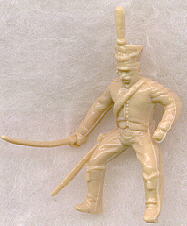
8029 Napoleonic French Chasseurs



Dated: August 17, 1999
This set contains several accessories (a standard, two sabres and a bugle) with which you can customize your chasseurs. The figures can be further customized by painting over the hussar boots or cutting off the plumes (leaving the pompoms) to show different Chasseur regiments.
There are 12 mounted figures per box, 4 poses of riders and 2 of horses. Here are the poses.



This first pose has a ringhand and can be fitted with a standard or a sword,

or a carbine from our Horse Grenadier set, but the figure's own carbine will have to be cut off to prevent him from having two guns.



This second pose also has a ring hand and can be fitted with the sword foward as in blocking a sword cut or backwards as in slashing down.


These are the oher two poses.
The following are the horse poses.


Bugle

All scaned at 100 DPI, 200%
Here are some more notes:
The French cavalry was divided into heavy, line and light cavalry. The French Chasseurs à Cheval were part of the light cavalry. Their role was to act as scouts for the infantry and the cavalry. This was not their only role and they participated in almost every battle and charged alongside the light and heavy cavalry units. At Waterloo, the Chasseurs à Cheval had 8 regiments in the field and represented the third largest fighting cavalry unit, after the Cuirassiers and the Dragoons. This set is presented with the long plumes on the shakos. Various color schemes can convert your French Chasseurs into cavalry units from many nations (Italy, Naples, Confederation of the Rhine etc.). (Philippe Petolon)
Editor's notes:
In the French Army there were 3 types of French light cavalry: hussars, chasseurs and lancers. Of the three, only the chasseurs were of French origin. The word chasseur means hunter literally, and applied to any lightly armed and mobile soldier, mounted or on foot. The hussars were copies of Hungarian hussars, the lancers were copies of Polish lancers. All 3 had the same roles, skirmishing, reconnaissance, scouts, even shock action when required.
Of the 3, the hussar were credited with more elan, more dash. The lancers with their special weapons had their special roles also, being in the first line of a cavalry formation, charging an infantry square etc.
Of the 3, only the chasseurs had no specialty and despite being the most numerous light cavalry type, is most often neglected. For example, no one ever said "any Chasseur à Cheval who is not dead by 30 is a blackguard". Sir Arthur Conan Doyle's dashing Brigadier Gerard was a hussar, not a chasseur. Many more countries had hussars than chasseurs. The hussar has been done 3 times in one 1/72 scale, the line chasseur never, etc., etc.
The basic chasseur uniform changed 3 times during the Napoleonic era, but was basically the same: green tunic and pants and a shako (with variations of colors and other things). The tunic started off as a hussar like dolman (with braids across the front), then went to a habit-long (long tail and lapelled), then a Kinski (single breasted and short tailed), and finally to a habit-veste (like the Kinski, but lapelled). The headgear evolved from a mirliton to shakos of different widths and heights. Busbies were worn by elite companies or officers. Our chasseurs wear the Kinski tunic, breeches and shakos. They also sport a long plume on their shako, but this can be cut off to leave on the more common pompom.